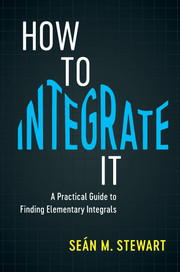Book contents
- Frontmatter
- Contents
- Preface
- 1 The Riemann Integral
- 2 Basic Properties of the Definite Integral: Part I
- 3 Some Basic Standard Forms
- 4 Basic Properties of the Definite Integral: Part II
- 5 Standard Forms
- 6 Integration by Substitution
- 7 Integration by Parts
- 8 Trigonometric Integrals
- 9 Hyperbolic Integrals
- 10 Trigonometric and Hyperbolic Substitutions
- 11 Integrating Rational Functions by Partial Fraction Decomposition
- 12 Six Useful Integrals
- 13 Inverse Hyperbolic Functions and Integrals Leading to Them
- 14 Tangent Half-Angle Substitution
- 15 Further Trigonometric Integrals
- 16 Further Properties for Definite Integrals
- 17 Integrating Inverse Functions
- 18 Reduction Formulae
- 19 Some Other Special Techniques and Substitutions
- 20 Improper Integrals
- 21 Two Important Improper Integrals
- Appendix A Partial Fractions
- Appendix B Answers to Selected Exercises
- Index
9 - Hyperbolic Integrals
Published online by Cambridge University Press: 11 December 2017
- Frontmatter
- Contents
- Preface
- 1 The Riemann Integral
- 2 Basic Properties of the Definite Integral: Part I
- 3 Some Basic Standard Forms
- 4 Basic Properties of the Definite Integral: Part II
- 5 Standard Forms
- 6 Integration by Substitution
- 7 Integration by Parts
- 8 Trigonometric Integrals
- 9 Hyperbolic Integrals
- 10 Trigonometric and Hyperbolic Substitutions
- 11 Integrating Rational Functions by Partial Fraction Decomposition
- 12 Six Useful Integrals
- 13 Inverse Hyperbolic Functions and Integrals Leading to Them
- 14 Tangent Half-Angle Substitution
- 15 Further Trigonometric Integrals
- 16 Further Properties for Definite Integrals
- 17 Integrating Inverse Functions
- 18 Reduction Formulae
- 19 Some Other Special Techniques and Substitutions
- 20 Improper Integrals
- 21 Two Important Improper Integrals
- Appendix A Partial Fractions
- Appendix B Answers to Selected Exercises
- Index
Summary
The principal advantage arising from the use of hyperbolic functions is that they bring to light some curious analogies between the integrals of certain irrational functions.
— W. E. Byerly, Integral CalculusIntegrals containing hyperbolic functions proceed largely in an exactly analogous matter to the integration of trigonometric functions. One important difference is that hyperbolic functions are defined in terms of exponentials; this allows for the possibility to reduce such integrals to rational functions of ex. And as we shall see all hyperbolic functions are rational functions of the exponential function. However, it is often not desirable to reduce an integral containing hyperbolic functions to an integral consisting of a rational function in terms of the exponential function as many of the properties that exist between the hyperbolic functions can be taken advantage of in order to simplify otherwise difficult-looking integrals.
We begin by first reviewing the definition for the hyperbolic functions and some of their associated properties that will prove useful when integrating integrals containing hyperbolic functions.
§ The Hyperbolic Functions
You may recall that trigonometric functions are known as circular functions since sine and cosine can be defined as the coordinates of points on the unit circle x2 C y2 = 1. By analogy, the hyperbolic functions are constructed by replacing the unit circle with the right-hand branch of the unit hyperbola x2 - y2 = 1.
The two most common hyperbolic functions, the hyperbolic cosine and the hyperbolic sine functions are defined as follows:
Definition 9.1 The hyperbolic cosine function cosh: is defined by
Definition 9.2 The hyperbolic sine function sinh often pronounced as ‘shine’, is defined by
The remaining four hyperbolic functions, namely the hyperbolic tangent function tanh, the hyperbolic cotangent function coth, the hyperbolic secant function sech, and the hyperbolic cosecant function cosech, are defined in an exactly analogous manner to their trigonometric counterparts. Thus
From the definition for sinh and cosh, each of the four latter hyperbolic functions can be expressed as a rational function in terms of the exponential function. Graphs for all six of the hyperbolic functions are given in Figure 9.1.
- Type
- Chapter
- Information
- How to Integrate ItA Practical Guide to Finding Elementary Integrals, pp. 119 - 133Publisher: Cambridge University PressPrint publication year: 2017



